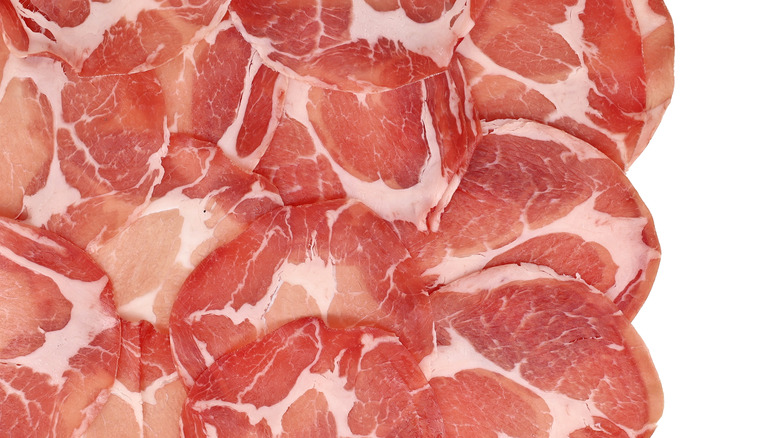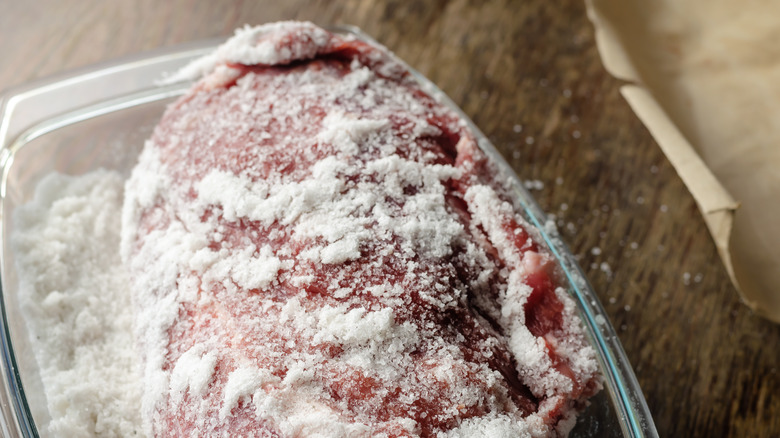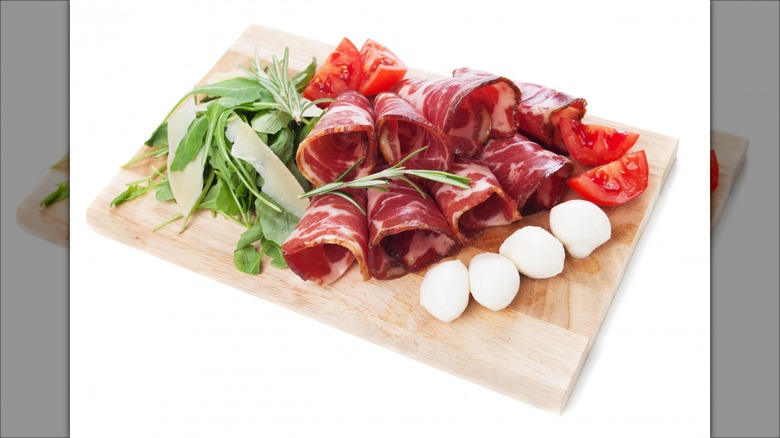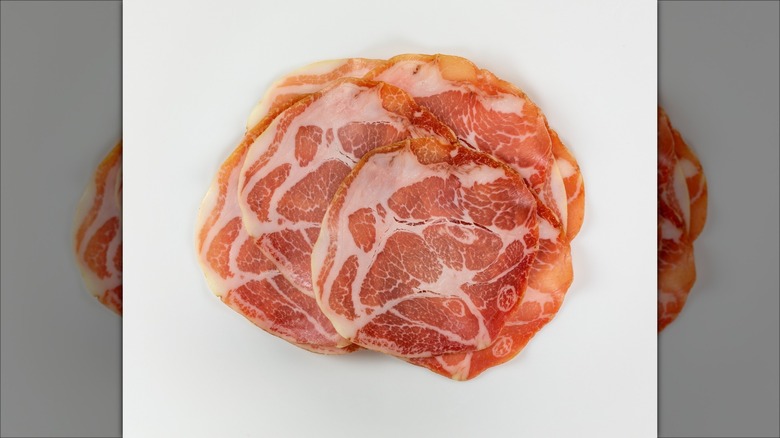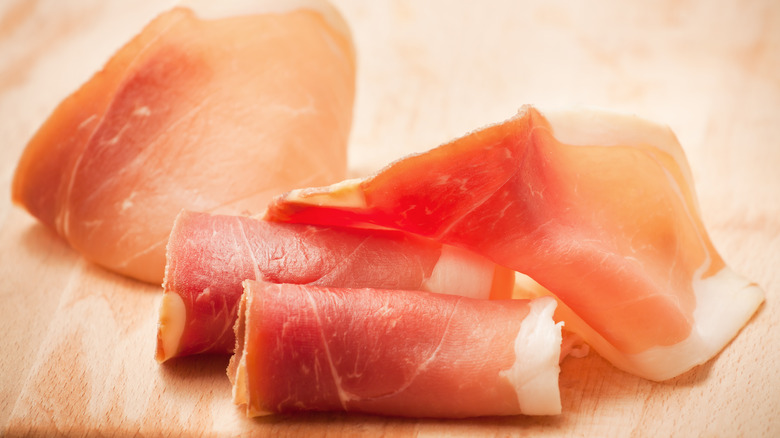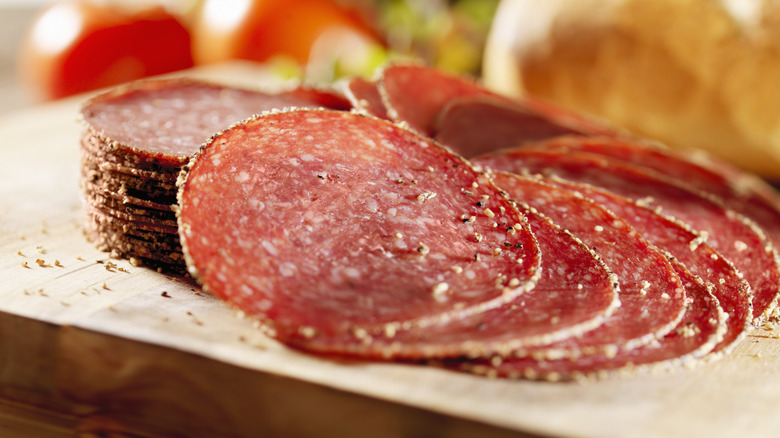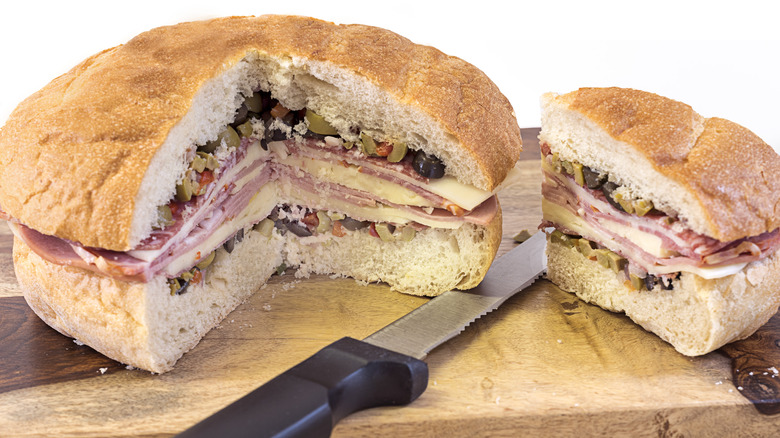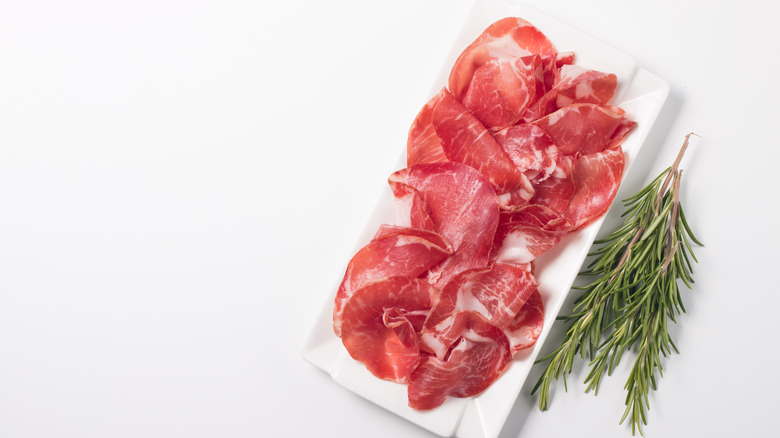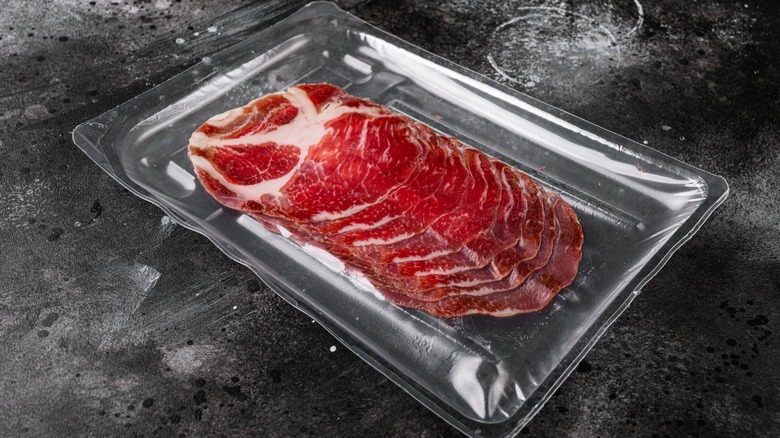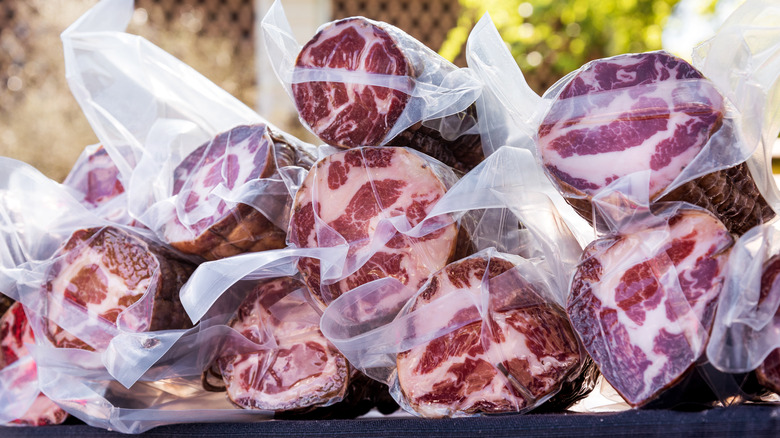What Is Capicola And What Does It Taste Like?
Since around 3000 B.C., ancient Mesopotamians have cured meat and fish in salt to extend their shelf-life. By the Roman empire, curing meat had become widespread, with many different dehydrated carnivorous delights finding their way into homes, onto the battlefield, and used as part of religious offerings. And though the myriad types of cured meat have proliferated since Roman times, pork remains a favorite among Italians.
Hundreds of different types of salumi are produced in Italy in one of two methods. The first uses whole cuts of meat, which get liberally salted and aged for several months, while the second involves combining different meaty bits, which get seasoned and placed in a casing before aging. One of the former types of cured meat is the popular variety known as capicola, or gabagool, if you happen to be a fan of the popular television series "The Sopranos."
We wanted to know more about this delicacy Tony Soprano couldn't get enough of, how to eat it, and where to find it. Let's look at the origins and elaborate production involved in making one of Italy's finest examples of cured meat — capicola.
What is capicola and how is it made?
Capicola, coppa, capocollo, or cappacuolo, is a type of ham that gets its name from the cut of meat it is made from. This cut spans from the neck of a pig to the fourth or fifth rib, connecting the head, called capo, to the shoulder, called collo. What makes this cut of pork so distinct is its lean-to-fat ratio, which is about 70/30, which yields a lusciously juicy finished product compared with many dry-cured salumi.
Though recipes for processing this cut of meat are as diverse as humankind, it is traditionally placed in a brine made from a combination of garlic, wine, herbs, and spices before it gets encased in salt. After a brief refrigeration, the pork is rinsed, and a fresh round of seasoning is applied. This commonly consists of red pepper, fennel, coriander, paprika, and aniseed. The prepared meat is transferred to a natural pork casing and hung to dry-cure for four to six months. At this point, it can be served as is, smoked, or slow-roasted, a variety known as coppa cotta.
Though similar whole-muscle salumi can now be found across the globe, capicola was first made in northern Italy, in the area of Piacenza, and in the southern region of Calabria. Capicola from either of these has been enshrined as having Protected Designation of Origin status by the European Union. This ensures that all aspects of capicola production have occurred within the region, from farm to table.
What does capicola look like?
The size of a full capicola can vary from 2 to 3 pounds depending upon the initial weight of the pork shoulder used. A capicola will generally lose about 35% of its moisture during curing unless it is aged longer.
At first glance, the interior of a capicola diverges from other types of salumi that are made sausage-style because it is a whole cut of pork. Unlike mixed meat salumi, which is a conglomeration of different cuts of meat thoroughly combined with seasonings before getting placed in a casing and dry-cured, capicola has a more variegated look. The rich veins of fat are striated throughout the flesh, which ranges in color from bright red to a more muted salmon hue.
When thinly sliced, you may notice the exterior of the capicola is more or less permeated by the seasoning blend it has been dry-cured in. Those with aggressive amounts of red pepper and paprika may have a slightly orange hue that begins to creep into the perimeter of the meat. Those seasoned with less brightly colored spices won't have any coloring.
Smoked or slow-roasted coppa cotta tends to have a far more muted interior color without evidence of the spices used during the curing process along the exterior perimeter of the meat. And while the veins of fat are still visible, they become slightly more opaque, having a muted off-white color rather than a bright, almost translucent snowy hue.
What does capicola taste like?
The flavor of capicola is complex, partly a by-product of the cut of meat itself. Because of the high level of fat in the shoulder, this salumi tends to be simultaneously creamier than other types of whole-meat salumi while maintaining some degree of chewiness. It also isn't gristly the way sausage-style salumi tends to be. When smoked or slow-roasted, its texture becomes even juicier, losing some of the toothsome chew characteristic of dry-cured ham.
Since taste is inextricably intertwined with aroma, we'd be remiss in not mentioning that capicola can have a mildly sweet and peppery nose with a hint of porky gaminess that is slightly reminiscent of bacon, particularly in its smoked iteration. Some of this can be muted in cooked capicola.
The full flavor of the particular spices used in curing capicola comes through when you allow a thin slice to begin melting on your tongue. As your body heat warms the meat through, elements of the fennel, coriander, or aniseed will start to emerge. And you may begin to feel the heat, depending upon what kind and how much pepper or paprika was used. The wine or garlic may confer some sweetness balanced by residual salinity from the curing process. It's an umami bomb of flavor, which is why it is so popular among Italians and non-Italians.
What is the difference between capicola and prosciutto?
Though capicola and prosciutto are similar types of whole-meal salumi, they are distinct. The most notable difference between them stems from the cuts of meat used, with capicola usually coming from the fatty shoulder and prosciutto from the leaner hindquarters. They also hail from different regions, with prosciutto being the porcine delight of choice among those in the northern Italian areas of Parma and San Daniele.
You will also note they are unique in size, with the capicola being significantly smaller. This is partly a product of cut but also the breed and age of pig used. Capicola comes from southern pig varieties, like the Apulo-Calabrese. These animals are about eight months old and approximately 300 pounds at the time of slaughter. Prosciutto uses northern breeds, like landrace, large white, and Duroc, which are at least nine months of age and closer to 360 pounds when processed.
Finally, preparation varies between the two. Prosciutto takes far longer to cure, up to two years. It also tends to be less intensely seasoned, often using just salt and pepper with the occasional addition of juniper berries and rosemary. This yields a milder flavor. The lengthy curing process also produces meat that is far lighter in color, has a denser texture, and costs significantly more.
What is the difference between capicola and salami?
While both capicola and salami fall under the salumi umbrella, the latter refers specifically to cured meats, typically types of sausages, that undergo fermentation and are air-dried for preservation. There are hundreds of different kinds of salami produced from the top to the bottom of the Italian peninsula, and beyond, each having a distinct flavor and texture. While pork is the predominant meat used, beef, veal, venison, or even poultry may also be incorporated into the ground mixture. This meat is blended with chunks of fat, various herbs, spices, and aromatics, like garlic and wine, and sometimes preservatives, like sodium nitrate, before being stuffed into a casing and left to dry in a dim, chilled environment. Salami can be air-dried to varying degrees of hardness, from still chewy to very dense and hard to slice.
Salami often get their monikers based on the feature ingredient from which they are made, or the city, region, or country from where it hails. One of the most recognizable types of salami is the Genovese variety. This delicately-ground, hard salami from the northwestern haven of Genoa, has notable chunks of fat strewn throughout the sausage, and tends to be enriched with garlic, fennel, black and white peppercorns, and wine. Other distinct varieties include the Tuscan fennel and pepper filled finocchiona salami, and the legendary soppressata, which can range in flavor from sweet to spicy depending on its origin.
How to cook with capicola
Aside from using capicola as the star on a charcuterie or antipasto platter, this salumi has myriad other purposes in the kitchen. Because of its slightly spicy flavor and marbled texture, it is a spectacular meat to add to a classic pasta dish, like a carbonara or penne alla vodka, or a topping for a homemade or store-bought pizza. As the capicola bakes, its fat will begin to render, spreading juiciness and flavor across the pie. We recommend keeping it simple with just a light marinara, fresh mozzarella, and perhaps some basil to allow the capicola to be the focus of the pie.
Capicola is also a popular addition to salads and sandwiches. Though it would be lovely in an Italian twist on a grilled cheese sandwich, like a panini, it is probably best known for being featured in a classic New Orleans staple — the muffuletta. This sandwich has only three ingredients, so each has to be superior. The bread must be a round ciabatta or similar loaf that can absorb the olive salad, a tapenade mixed with giardiniera. These are topped with assorted cold cuts with diverse flavors and textures. Once assembled, the sandwich is left to set, with the ingredients coming together and saturating the bread to perfection.
Nutrition of capicola
Where the nutritional value of any cured meat is concerned, moderation is key. Though capicola contains high amounts of protein, iron, and vitamin B12, these may not outweigh some problematic areas. Capicola gets a lot of flavor from the fattiness of the shoulder meat it is made from. This means it is high in fat. One two-ounce serving has approximately 10 grams of fat and 3.5 grams of saturated fat. According to the Mayo Clinic, only 10% of your daily calories should come from saturated fat. For the average person consuming 2,000 calories a day, that should be around 22 grams.
Another area of concern for those with high blood pressure or kidney conditions is the sodium content of capicola, which is roughly 840 milligrams per serving, or 35% of the recommended daily value. And finally, capicola may contain nitrates or nitrites, depending upon the manufacturer. Nitrates and nitrites have been associated with an increased risk of gastric cancers, based on a 2015 research study published in PubMed.
A couple of last notes regarding capicola. For those with gluten allergies, most capicola is considered gluten-free. Pregnant women should avoid uncooked capicola due to the potential contamination by microbes in undercooked or raw meats.
Where to buy capicola
The resources available to purchase capicola are virtually endless, depending upon what type you are looking for. If you want a pre-made capicola, you can buy it from local butcher shops, the best grocery store deli counters, Italian specialty markets, and online resources, including Amazon Fresh and Instacart. You can filter the type you prefer by the level of spiciness, where it was produced, and whether or not it has been smoked. You can also purchase it pre-sliced or have it sliced to order.
For those wanting a capicola sandwich, plenty of shops offer various iterations. Search out a classic Italian deli or find a local butcher with a prepared food counter. Many of these will whip up a house version of a muffuletta that will knock your socks off.
Finally, if you are creative, we recommend getting a do-it-yourself kit to make homemade capicola. Several online resources exist for purchasing kits with everything you need and detailed instructions. This will allow you to tailor your seasonings to your liking and tweak the recipe accordingly. Follow the instructions carefully to ensure the meat is safe and free from potential pathogens.
How to store capicola
Though capicola should never be stored in the pantry, as far as deli meats go, it is one of the more long-lasting varieties, thanks to the fact that it is cured. The low-moisture and high-acidity levels in capicola make it particularly resistant to bacteria proliferation, when properly stored in a refrigerator. If you get pre-sliced capicola, leave it in the container it was packaged in, separated by any deli paper lining that is used between the slices, or transfer these to an airtight container. This should be stored in the refrigerator away from light and other foods that could easily absorb the strong aroma and flavors. Though you can reference the expiration date on the container, always use your nose and eyes. If the meat looks discolored or smells off, discard it. Once a package has been opened, it will typically last about five days.
When it comes to freezing capicola, the same factors that make it resilient to bacteria make it somewhat more forgiving to cold temperatures, compared with other juicy deli meats. That said, do keep in mind that freezing may impact its texture, rendering the capicola less firm and potentially giving it a more mealy mouthfeel. The best way to retain its quality is to encase it in foil or plastic wrap, before placing it in a freezer bag or airtight container. This should be kept in the coolest portion of the freezer, away from the door, for up to three months.
